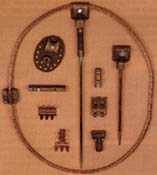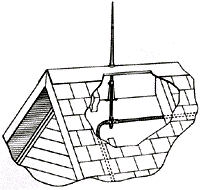Copper Lightning Protection Systems Save Lives, Billions
 The extensive network of lightning rods, cables and clamps needed to properly protect a commercial building or factory against lightning.
The extensive network of lightning rods, cables and clamps needed to properly protect a commercial building or factory against lightning."Scores of lives and billions of dollars in property could be saved each year if buildings were properly protected against lightning," according to C. Andrew Larsen, executive director of the Lightning Protection Institute, Arlington Heights, Illinois. "Lightning is the most common cause of building fires, especially in rural areas. And when lightning strikes an office building, refinery or factory, it can do more than injure employees and damage property: it can disrupt operations, resulting in loss of profits." A single lightning strike could cause thousands of dollars per hour in lost production. The average lightning strike carries 30-million volts.
Copper and its alloys are the most common materials used in lightning protection, although manufacturers of lighting protection offer the same products made of either copper or aluminum.
Leo Soucy, owner of Facilities Engineering Associates (FEA), Farmington, Connecticut, reports his if engineers specify only copper in lightning protection "because of copper's superior current-carrying capacity and to avoid oxidation problems at connections associated with aluminum." FEA designs data centers for companies such as General Electric.
Wayne Koshofer, president of Koshofer Lightning Protection, Putnam Valley, New York, also prefers copper: "Copper is much easier to work with. For instance, copper cable bends easily compared to brittle aluminum.
Copper is also esthetically superior. Exterior copper wiring weathers to a pleasing dark shade."
Ted Ciemiengo, who heads Warren Lightning Protection, Collinswood, New Jersey, an installation company, reports "some 75% of the materials (cables, rods, etc.) we use are copper."
 It is less costly to install lightning protection at the time of construction, and more esthetic as well. Cables running from lightning rods on the roof to buried grounding rods can be concealed easily when installed during construction. Proper lightning protection for a home costs between $1,000 and $2,000, depending on home size.
It is less costly to install lightning protection at the time of construction, and more esthetic as well. Cables running from lightning rods on the roof to buried grounding rods can be concealed easily when installed during construction. Proper lightning protection for a home costs between $1,000 and $2,000, depending on home size.A minority of industrial and commercial buildings and less than 10% of American homes are effectively protected, even though the lightning rod was invented by Benjamin Franklin nearly 250 years ago. From "80% to 90% of installations are ordered after a catastrophe," according to Joseph A. Lanzoni of Lightning Eliminators & Consultants (LEC), Boulder, Colorado, which both manufactures and installs lightning protection. Lanzoni says a lightning strike that causes little or no apparent damage can shut down electronically controlled operations for hours or even days.
"Protection against lightning is especially important for prisons and hospitals where authorities want to avoid evacuating inmates or patients in case of fire," reports Chuck Akerman, head of East Coast Lightning Equipment, Inc., a manufacturer in Winsted, Connecticut.
Home Market is Huge
According to Robert Cripe, head of Independent Protection Co., Inc., a manufacturer of protection products in Goshen, Indiana, "Lightning protection for homes is the next great market." The main reason is the increasing awareness of the destructive effects of lightning, especially fire.
Electronic products are particularly sensitive to lightning-induced voltage surges caused by lightning striking buildings or nearby transmission lines. Homes on elevated sites are particularly vulnerable, but all homes are at risk. Tall trees near homes don't protect against lightning, but actually constitute a threat (see page 1). Although lightning is most prevalent when it's warm and humid, it can strike at any time of year in any weather.
Proper rounding Essential
To be effective, lightning protection systems d must be grounded properly. Usually, this calls for burying copper-clad steel rods 10- to 40-feet long vertically in the surrounding earth. To ensure effective grounding in low-conductivity earth, such as sand, LEC has developed the "Chem-Rod," a long, hollow copper tube filled with metallic salts. The salts leach through holes in the tube, making the surrounding soil much more conductive.
Protecting Trees
Large trees, especially those adjacent to buildings, need protection because lightning can: shear off heavy branches that could damage nearby structures; set a tree ablaze, igniting nearby structures and other trees; and, strike a tree and "side flash" or travel through the ground damaging nearby buildings. Also, you may want to protect a prized tree, like the famous, 400-year-old "Wye Oak" in Maryland, which has extensive lightning protection. Copper is preferred for protecting trees because it stands up better to the organics in trees, especially when they're wet, according to Douglas Franklin, president, Thompson Lightning Protection, St. Paul, Minnesota, a manufacturer of protection equipment.
Lightning Protection Institute: 800/488-6864.
Independent Protection Co.: 219/533-4116.
East Coast Lightning Equipment: 203/379-9072.
Facilities Engineering Associates: 203/677-2285.
Koshofer Lightning Protection: 914/528-7455
Lightning Eliminators & Consultants: 303/447-2828
Thompson Lightning Protection: 612/455-7661
Warren Lightning Protection: 609/854-7000
Also in this Issue:
- Copper Blocks Ugly Bugs
- For Fast, Even Cooking
- Copper "Fashionable" in Jewelry
- Copper Lightning Protection Systems Save Lives, Billions
- Copper and Brass Tokens Boost Business
